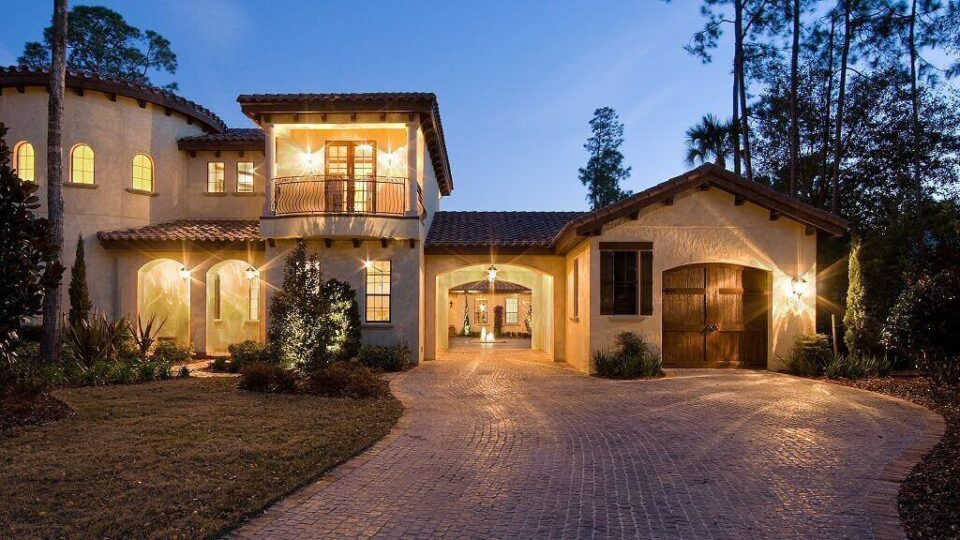Outdoor lighting runs the gamut from adding safety and security around a home’s exterior to purely aesthetic. And most of the time, this lighting is hard-wired into the home’s electrical system. If you are looking to update your outdoor lighting, it can be a great way to add ambiance and charm. And it is usually a small project that many homeowners try to tackle on their own. But even small jobs can pose big dangers.
When it comes to working with electricity, it is almost always better to err with caution and hire a professional to install outdoor lighting. According to the Electrical Safety Foundation, these seemingly simple installations are responsible for at least 40 deaths and 360,000 loss-of-property fires. Here are some tips that can make sure your outdoor lighting project is installed safely:
Use Fixtures and Bulbs Rated for Outdoors
Table of Contents
Outdoor lighting is frequently exposed to moisture and high temperatures, which are two things that do not typically pair well with electricity. Therefore, outdoor lighting fixtures and bulbs are generally built with added protections like seals that prevent moisture from reaching the interior of the fixture.
An indoor fixture would not typically be exposed to the same variables and is therefore not designed to withstand the weather. It is generally safe to use an outdoor fixture or bulb in either an indoor or outdoor setting. However, it is not safe to use an indoor fixture or bulb outside.
Match Bulbs to Fixtures to Prevent Over-Lamping
Light bulbs come in a variety of watts, typically rated as 60W, 75W, or 100W for outdoor lighting. You have probably seen these markings all over light bulb packaging and even printed directly on the bulbs. There is a good reason that bulb manufacturers make this information apparent. Every light fixture also has a corresponding rating which indicates how much power the fixture can safely tolerate. Mismatching your bulbs and placing a 100W bulb in a 60W fixture will likely cause overheating. The best-case scenario is that this leads to premature failure for the bulb or fixture, but oftentimes it causes a fire or serious electrical damage.
Watch Out for These Common Flammable Materials
Many household fires are caused by negligence. The simple inaction of looking for and removing safety hazards causes more than 800 million in property damage every year. When it comes to your outdoor lighting, keep a watchful eye out for these common flammable materials:
Automotive Products: Anything in your garage, including brake fluid, motor oil, and anti-freeze, are all highly flammable and should be stored in a fire retardant cabinet away from lighting fixtures, electrical outlets, or doorways.
Pool Chemicals: Chlorine and other products frequently used to maintain a swimming pool or outdoor water feature are other red flags for flammable materials around your outdoor lighting.
Lawn Care Products: Chemicals used to treat the yard, kill weeds, and organic compounds like fertilizer are all flammable and should be stored a safe distance from outdoor lighting and electrical.
Use Appropriate Weather-Resistant Protection
When installing outdoor lighting, it is important to carefully consider the environment. If frequent exposure to moisture is expected, as in a pool area or an uncovered outdoor area of the home, then outlets and receptacles should be designed with that in mind. It is a good idea, and potentially even required by building codes, to use GCFI outlets and weather-resistant receptacles. Homeowners should also make sure that extension cords are rated for outdoor use when they are used.
Safety Considerations for Holiday Lights
One of the most commonly overlooked safety concerns when it comes to outdoor lighting is Christmas lights. Putting these whimsical decorations up is quite common and ingrained in our culture that safety is rarely a concern. But between falling off ladders and suffering a home fire from faulty Christmas lights, the risk is there.
- Make sure to use holiday lights rated for outdoor use.
- Use tested and certified lighting designated by the Underwriter’s Laboratories (UL) or the Electrical Testing Lab (ETL), which should be prominently marked on the box.
- Buy new lights using LEDs or another modern lighting technology that emits a cooler light.
- Double-check your lights and extension cords to make sure they are approved for outdoor use below freezing temperatures.
- Check to make sure all lights work before putting them up.
- Only hang lights with insulated wire holders or coaxial cable holders.
- Do not attempt a DIY arrangement by splicing two or more strands together.
- Pay attention to the load on a particular extension cord or outlet, so you don’t overload a circuit.
Summing Up Outdoor Lighting Safety
The lights around the exterior of your home are just as important as the ones inside. Any fixture that is hard-wired into the home’s electrical system presents a potential for a fire or electrocution. Adding security or ambiance to your home’s exterior isn’t worth a trip to the hospital. So, if you are feeling outmatched, it is best to call a professional electrician for jobs of all sizes that deal with your home’s electrical system.
Author:
Bobby Lynn is the Owner of LiveWire Electrical, a fully licensed and insured residential and commercial electrical company serving Charlotte, NC, and surrounding areas. Bobby has been in the electrical industry for over 20 years and has a vast knowledge of all things electrical.

